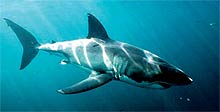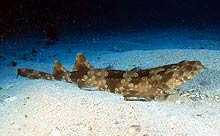Worldwide, there are about 370 shark species and almost half (170 species) are present in Australian waters.
Sharks are found in a broad range of marine habitats from shallow coastal waters to the deep ocean (deeper than 2000 metres) and from the tropics to the polar regions. Some live in the open surface waters of the ocean and others spend their lives on the seafloor.
Distribution
Geographic and depth distributions are known for most shark species and this information is constantly being updated as a result of continuing research. Although this data can tell us about the areas sharks are inhabiting, it does not tell us about their preferred habitats, population sizes, movement patterns or other factors that might help to find out their role in the ecosystem.
The use of shark-tagging provides some of this information. Standard tags have a unique identification code printed on them. They are inserted into a shark when it is caught. If the shark is recaptured the code is written down, the shark is measured (if possible) and the location is noted down. This information is given to researchers who use it to try to understand more about sharks.
More advanced tags provide the exact location of the shark by sending information to a satellite. The researchers then download the information from the satellite and they can follow the movements of sharks quite accurately. Unfortunately, this satellite technology is very expensive and limits scientific investigations to key species such as the grey nurse shark (Carcharias taurus), which is critically endangered on the eastern coast of Australia.
|

The great white shark
(Carcharodon carcharias )
(© Ken Hoppen, oceannotions@primus.com.au)

The spotted wobbegong (Orectolobus maculatus) may grow up to three metres long. This
camouflaged shark commonly ambushes
passing prey, that includes teleost fishes,
crabs, rock lobsters and octopuses.
(© Ken Hoppen, oceannotions@primus.com.au)
|
